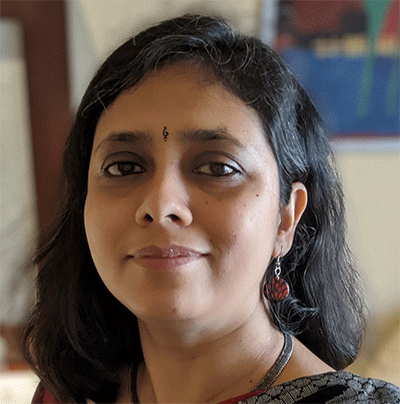
Sushmita Mandal (she/her), SEI Asia

Maria Sapatu-Kennar (she/her), Eco Current Consultancy


The WASH sector understands the link between the environment and service provision, but probably still lacks a broader environmental perspective. Hannah Neumeyer explained: “Working in WASH, my question is always: Who has services, who doesn’t, will services last? When we talk about sustainability, we first think about water or sanitation services breaking down because they are not maintained. It is time to change that.”
Sushmita agrees that looking at the principle of sustainability from a WASH sector perspective, the focus has primarily been on infrastructure and actors. But when we talk about ‘sustainability’ from this narrow perspective, we lose the question of the broader environment. We need to change this narrow perspective and take in consideration source sustainability. With the current climate crisis, slow onset disasters such as droughts can lead to water unavailability, and the key to addressing water insecurity lies in building resilient systems.
Read an opinion piece outlining the origins of pollutants and discussing the regulatory challenges in many countries: Why wealthy countries and companies need to do more to clean up global toxic chemical pollution, D. Paramita and M. Al Afghani
Maria Sapatu-Kennar explained that with climate projections of increased intensity and frequency of days of extreme heat, extreme rainfall, ocean acidification, sea level rise, prolonged drought periods and more frequent and intense cyclones – this will definitely have devastating impacts on water quality and quantity, water supply and treatment infrastructure. A narrow look at standard setting and regulation will therefore be insufficient to ensure the realisation of the rights to water and sanitation.
There is an affordability dimension too: Affordability in the WASH sector is about whether a household can afford the water and sanitation service costs. But including a broader perspective, this very part of ‘affordability’ is highly influenced by environmental degradation of water resources, among other things. Looking at whether water companies are regulated so that water and sanitation remains affordable is at some point not sufficient.

“In Samoa, the water division falls under the ministry of environment – so the sharing of information related to access to water and environmental policies is up to speed.”
Maria Sapatu-Kennar
An example that illustrates this: emerging contaminants released in the water are often hard to detect, and research on their harmfulness is often lagging behind. Treatment of water for drinking becomes more expensive and complicated when it has more chemicals in it. Governments often don’t have the (financial) capacity to research and make regulations that keep up with new types of pollution.
The WASH sector therefore needs to increasingly look beyond its own agenda. We need to broaden our horizons when we work on water, sanitation and hygiene. We need to consult and collaborate with other sectors and experts to work towards lasting solutions for the realisation of rights. Maria adds that an intersectoral approach is important in terms of governmental institutions and regulation. “In Samoa, the water division falls under the ministry of environment – so the sharing of information related to access to water and environmental policies is up to speed”, she said.
One of the ways to work towards solutions is to link with other sectors. When working on water and sanitation issues – impacting for instance the sustainability, affordability, or quality of services – we can reach out to organisations or institutions with expertise on environmental and climate change impacts. Furthermore, civil society organisations can assist local governments in becoming more aware of the interdependence of measures taken for both the environment and access to water, sanitation and hygiene. Sushmita emphasises that solutions need to be decolonised.

“For solutions, we need to turn to local knowledge, at the levels where impacts are actually happening, and where people have gained experiences and found ways to live with the impacts.”
Sushmita Mandal
“When we seek solutions for – for instance – pollution of water resources, we need to focus on the ‘majority world’ (sometimes called Global South),” Sushmita said. Solutions exist in local knowledge systems. These are context specific and involve local communities – and these solutions are currently not known or fully understood. She added: “Much of the WASH sector’s development work has focused on behaviour change and infrastructure, that is great but also could gain from being rooted in the local context and ethic.” An example shared by Sushmita includes local communities close to Kolkata, who found ways to use the sewage disposed by the city for their livelihoods. Devised by local fishermen and farmers, these wetlands serve as the natural sewage treatment plant for the city. The East Kolkata Wetlands host the largest sewage fed aquaculture in the world.
A positive example includes the Climate Risk and Early Warning Systems (CREWS project) at the Pacific Climate Change Centre (PCCC), which already pro-actively uses traditional knowledge for the functioning of their Early Warning Systems. Maria explained: “Our ancestors have predicted certain weather, such as heavy rainfall, by blooming of a certain flower for example.” The CREWS project is working together with Pacific communities and their governments on incorporating this traditional knowledge into climate risks and early warning systems.
Maria emphasises the need for data sharing– platforms, policies, resources and systems in place across sectors, so that information is readily available for effective monitoring, early warning systems and as advice to decision makers and practitioners. She illustrates that the PCCC works closely with meteorological offices in developing early warning systems. This is shared with key stakeholders such as agriculture and environment and water resource departments.
Hannah points out that human rights demand participation of the people affected. Unfortunately, this is often done in a tokenistic manner at best. It’s evident from these examples that this is not just wrong, but also short-sighted. Crucial for any solution, therefore, is decolonisation and localisation finally being discussed in the WASH sector.
The recognition of a clean, healthy and sustainable environment as a human right clarifies the role of the state as primary duty bearer. This opens up new ways of seeking government response and accountability, including notably through courts. In addition, it demands responses in the legal, regulatory and policy environment of a country, despite the challenges, as the example of emerging pollutants shows.
Increasingly, those of us working across different sectors need to collaborate, share data and information and tackle issues with a multiple dimensional approach. When different disciplines do work together, solutions can be found to mitigate and adapt. These solutions must be context specific and focus on local, traditional knowledge.
Publisher: WASH United gGmbH
Fuerbringerstrasse 7 | 10961 Berlin | Germany
Telephone: +49 (0)30 555 768 060
Email: info@wash-united.org